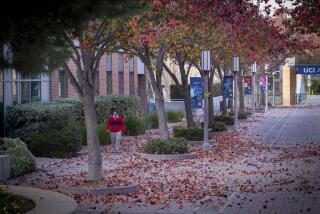Universitiesâ Budget Cuts Are Reduced
After several days of intense negotiations, officials at the University of California and the California State University have persuaded the Deukmejian Administration to reduce a proposed 2% budget cut for the current fiscal year so that the two public university systems will not have to impose mid-year fee increases on students.
Under the terms of a general agreement worked out Monday afternoon, the nine-campus UC system and the 19-campus Cal State system will still have to cut their operating budgets for the current year by more than 1%, which will mean freezes in hiring and delays in campus maintenance and purchases of equipment, supplies and books.
But because the revised budget plan no longer imposes the full 2% reduction that Gov. George Deukmejian had originally requested in December to ease the stateâs budget difficulties, students will not have to shoulder the burden of the budget cuts this year.
âItâs a real victory. We are pretty well pleased,â said William B. Baker, UCâs vice president for budget.
âThe governor was simply resistant to making any mid-year fee increases for students,â said Lois Wallace, spokeswoman for the Department of Finance. Instead of a $35.5-million cut, UC will now face a $20.5-million cut. And instead of $27.5 million, Cal Stateâs budget will be cut by $16.5 million, she said.
In announcing the 2% cuts in December for nearly all state agencies, Deukmejian said it was his goal to save $100 million over the last six months of the fiscal year.
Student Fee Hikes Considered
Anticipating the full 2% cut from its $1.9-billion state-funded budget, UC had discussed raising student fees by $130, or 9.1%, which would have raised about half the needed revenue to make up for the stateâs cuts. As of Monday morning, Cal State officials were still discussing a $48 fee hike for full-time students, which would have brought total fees to between $689 and $787, depending on the campus, and raised nearly $14 million of the $27.5 million the university would have needed to recoup what the state planned to cut.
As it stands now, Cal State spokesman Jeff Stetson said, the Cal State system will cope with its $16.5-million shortfall by making reductions in campus maintenance and travel, as well as freezes on the purchase of certain supplies.
According to Baker, UC will place a freeze on hiring non-teaching staff, cut travel and defer some maintenance projects.
Although there was some relief expressed on campus that the universities would not have to raise fees, the idea of a mid-year budget cut was not greeted by enthusiasm by any public university official, particularly in light of the governorâs austere budget for next year.
Under the fiscal 1988 budget plan, UC and Cal State are to receive 5.6% and 5.5% increases respectively. But even those modest increases are to be reduced, because they were accompanied by a mandate from the governor that both systems make unspecific cuts of 1% for next year out of the total they have been allocated. Moreover, students are to pay about 9% more next year than they are now paying.
The tight budget for next year, campus officials said, will mean that the universitiesâ salaries will not remain competitive with those of other state universities. Moreover, neither UC nor Cal State will be allocated enough money to cover inflation next year for such unavoidable costs as utilities and library purchases.
The budget cuts for this year and the relatively tight budgets for next, however, come after several years of generous spending increases for public higher education, which have boosted the public universitiesâ overall budgets by nearly 50% in three years.
More to Read
Sign up for Essential California
The most important California stories and recommendations in your inbox every morning.
You may occasionally receive promotional content from the Los Angeles Times.










